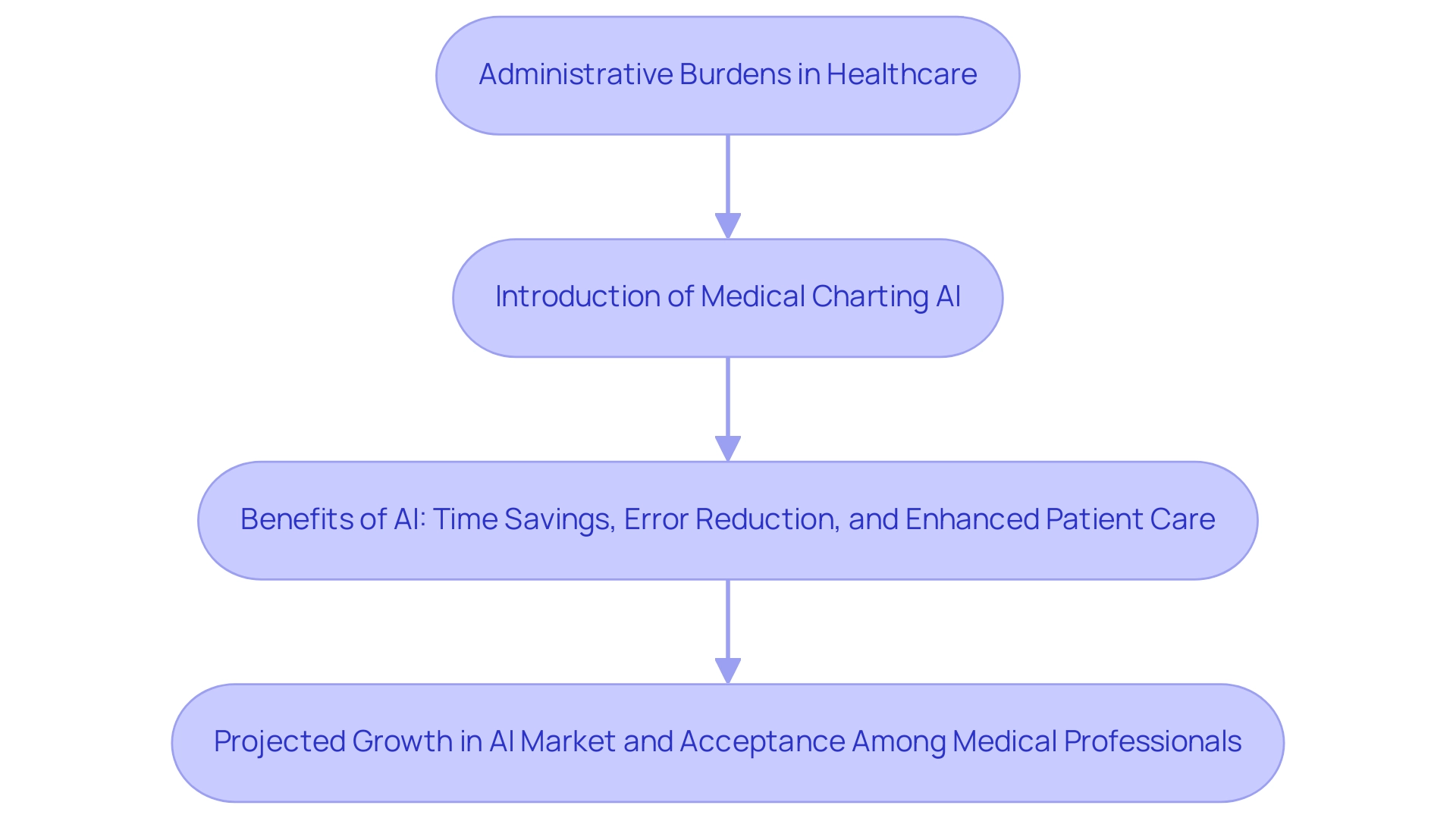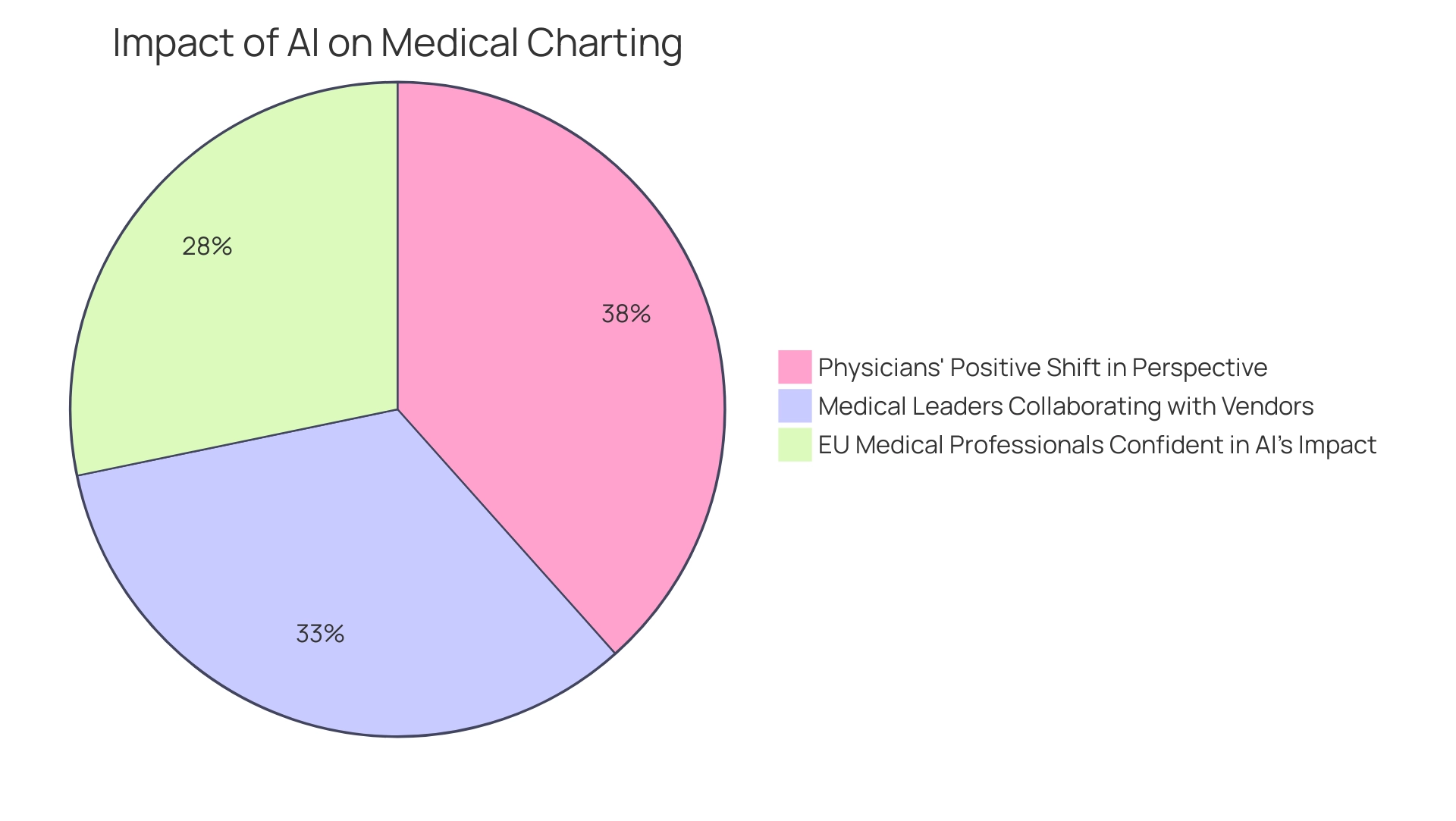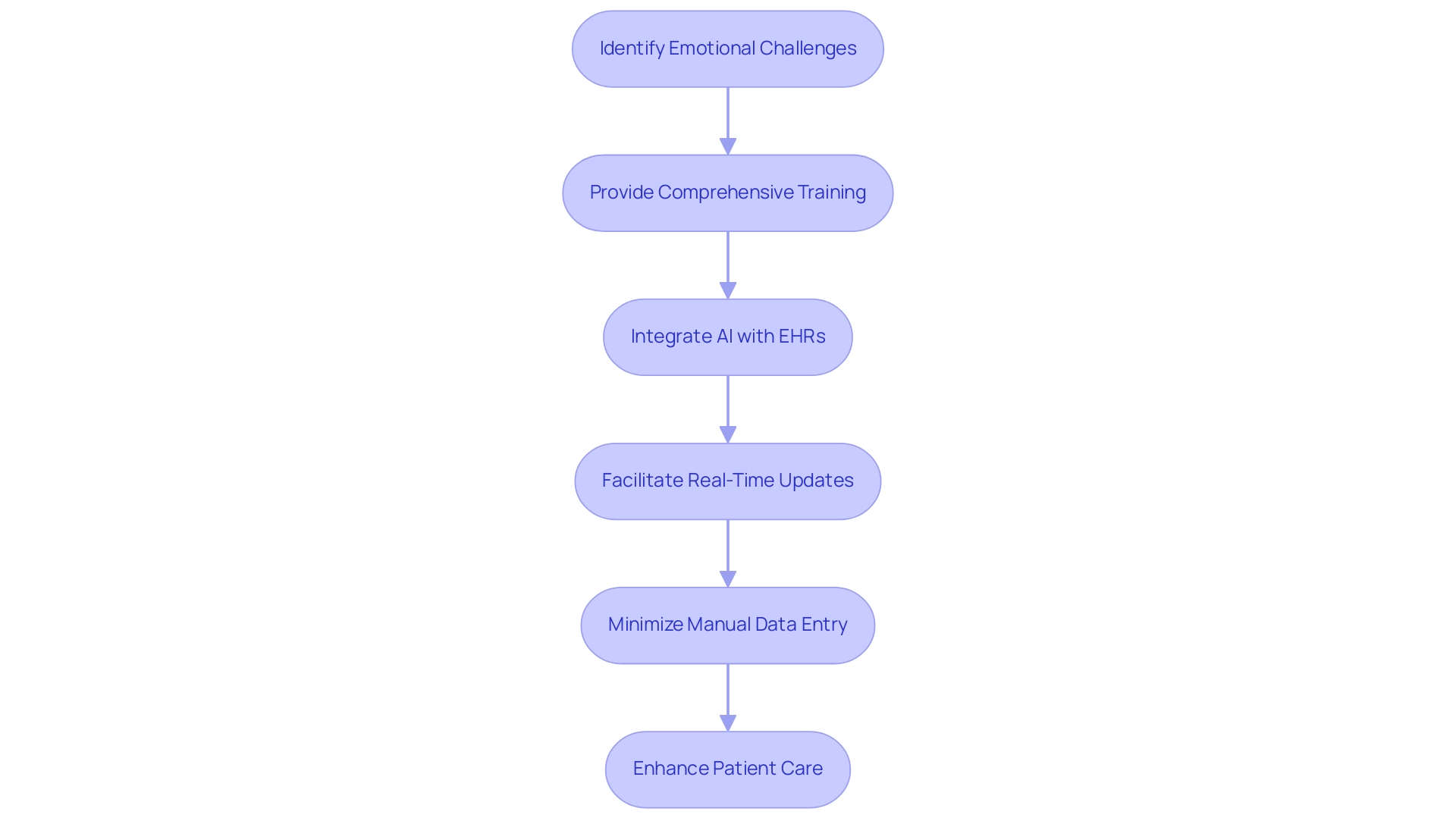Overview
In the demanding world of healthcare, providers often face overwhelming administrative burdens that can detract from their primary focus: patient care. Have you ever felt the weight of endless documentation? It's a common struggle that many in the field experience daily.
This is where medical charting AI comes in as a supportive ally. By automating administrative tasks, it not only enhances efficiency but also allows healthcare providers to dedicate more time to what truly matters—their patients. Evidence shows that AI reduces the time spent on documentation by an impressive average of 2.5 hours each day. Imagine what could be achieved with that extra time!
The benefits are profound. With less time spent on paperwork, providers can foster improved patient engagement and satisfaction. Moreover, this technology helps minimize errors in medical billing and documentation, creating a more seamless experience for both providers and patients.
As we embrace these advancements, it’s essential to consider how they can transform our approach to care. Let’s continue to explore these solutions together, ensuring that we prioritize the well-being of our patients while navigating the complexities of healthcare.
Introduction
In the evolving landscape of healthcare, the integration of artificial intelligence (AI) into medical charting marks a significant shift towards innovation and efficiency. Healthcare providers often find themselves overwhelmed by the dual demands of patient care and increasing administrative burdens. This is where AI steps in as a true ally, streamlining documentation and enhancing operational workflows. With a remarkable number of healthcare organizations embracing AI technologies, this transformation is not just a passing trend; it is essential for improving patient outcomes and alleviating clinician burnout.
Imagine a world where routine tasks are automated, allowing healthcare professionals to focus more on their patients. AI tools are paving the way for a more patient-centric approach, enhancing the accuracy of medical records and fostering better communication. As the industry continues to evolve, understanding the implications and best practices for implementing AI in medical charting becomes crucial. Providers who aim to stay competitive and deliver exceptional care can benefit immensely from embracing these advancements. Are you ready to explore how AI can transform your practice and improve the lives of your patients?
The Role of AI in Transforming Medical Charting
The incorporation of [medical charting AI](https://openandaffordable.com/post/ai-in-healthcare-statistics-and-trends) is fundamentally transforming the medical landscape, helping to alleviate the emotional burdens faced by professionals. Many healthcare providers grapple with overwhelming administrative tasks, which can detract from their ability to focus on patient care. AI tools are thoughtfully designed to automate and streamline documentation, significantly reducing the time clinicians spend on scheduling appointments, managing medical records, and handling billing. This shift not only enhances operational efficiency but also allows medical providers to devote more attention to their patients, ultimately leading to improved health outcomes.
Recent advancements in AI technologies have made them indispensable in medical documentation. A staggering 94% of or machine learning, reflecting a growing reliance on these technologies for decision-making processes among clinicians. By 2025, the medical chatbots market is projected to grow from $116.9 million in 2018 to an estimated $345.3 million, indicating a compound annual growth rate (CAGR) of 14.5%. This growth underscores the increasing integration of medical charting AI in various aspects of medical services.
Additionally, 59% of are partnering with third-party vendors for solutions, highlighting a collaborative approach to AI integration that addresses challenges for startups, such as resistance to innovation, and enhances care. Case studies reveal that medical charting AI not only enhances documentation efficiency but also improves accuracy.
For instance, medical providers utilizing AI solutions have reported saving an average of 2.5 hours in administrative tasks. Imagine the relief of having more time to concentrate on providing personalized patient support! Furthermore, AI tools that recommend precise diagnosis and billing codes greatly minimize mistakes, simplifying the insurance billing procedure and easing pressures on medical providers.
The virtual nursing assistant AI application market is anticipated to achieve $20 billion by 2026, signifying a major growth in AI applications within the medical field that promotes patient-focused support. Yet, expert opinions highlight the dual nature of AI's impact on medical relationships. While 57% of respondents believe AI might adversely affect their interactions with medical professionals, especially regarding the quality of those interactions, we cannot disregard the potential for AI to enhance the standard of treatment.
Dr. Jason Stott observes that the chatbots market's expansion mirrors a wider trend in AI utilization, emphasizing the necessity of balancing technological efficiency with empathetic interactions. In summary, the emergence of medical charting AI indicates a significant transition towards more efficient, precise, and patient-centered documentation. By leveraging AI solutions from CosmaNeura, medical professionals can combat burnout, enhance diagnostic accuracy, and ultimately improve patient care as the industry progresses.
Key Solutions:
- Automate administrative tasks to save time.
- Improve accuracy in documentation and billing.
- Enhance focus on personalized patient care.
As we navigate this evolving landscape, let’s embrace the potential of AI to support our mission of providing exceptional care to our patients.

Key Benefits of AI Tools for Healthcare Providers
In the demanding world of healthcare, providers often face overwhelming administrative burdens that can detract from their primary mission: patient care. Medical charting AI is here to offer a compassionate solution, significantly alleviating these pressures. By automating essential tasks such as scribing, billing, and documentation, these innovative tools save healthcare professionals an impressive average of 2.5 hours each day. This substantial time savings empowers clinicians to dedicate more attention to their patients, enhancing the overall quality of care in a sector that can be resistant to change due to concerns over maintaining that quality.
Imagine the relief of having more time to connect with patients. Medical charting AI not only frees up valuable hours but also plays a crucial role in minimizing errors associated with billing and documentation. By streamlining these processes, these tools enhance operational efficiency and contribute to better health outcomes for individuals. The generative AI medical charting market is projected to exceed $10 billion by 2025, reflecting a growing recognition of AI's potential to transform administrative workflows in medical settings.
Medical leaders are increasingly encouraged to develop strategic AI initiatives and invest in pilot programs to harness this technology's capabilities for future growth. Case studies reveal a growing acknowledgment among doctors across various specialties about the potential of AI, particularly among pathologists, who exhibit the highest confidence in its applications. This varied acceptance underscores the importance of context in implementing AI tools.
A recent Medtronic Morning Consult survey found that 51% of U.S. adults are optimistic that new applications of artificial intelligence will lead to major advancements and breakthroughs in medical services. This signals a shift in perceptions, highlighting the hope that AI brings to the healthcare landscape.
As the medical sector continues to evolve, the integration of medical charting AI solutions is not just a trend but a necessity for enhancing clinician efficiency and improving patient care. With a by 2032, the momentum behind AI in medical services is undeniable. It is essential for practitioners to adopt these advancements to remain competitive and efficient in their work. Moreover, recognizing that only 27% of White adults perceive racial and ethnic bias as a significant concern in medical services underscores the necessity for AI to tackle these disparities and enhance overall service delivery.

Enhancing Accuracy in Medical Documentation with AI
Compassionate AI solutions are truly transforming the interactions between healthcare professionals and individuals, especially when addressing the inherent resistance to innovation within the sector. By automating routine administrative tasks, AI allows clinicians to devote more time to meaningful interactions with individuals, enhancing the overall experience of support. For instance, intelligent transcription services facilitate real-time capture of conversations, enabling providers to prioritize understanding needs over documentation.
This transition not only enhances the quality of care but also strengthens the patient-provider relationship—a crucial element of effective service delivery.
As we look toward 2025, the impact of AI on the quality of patient-provider relationships is increasingly evident. AI-driven tools are enhancing personalized health recommendations, appointment scheduling, and medication adherence monitoring, leading to improved engagement among individuals. Have you noticed how a significant increase in patient satisfaction and adherence to treatment plans? Engagement levels are rising by over 30% in some practices.
Moreover, AI-driven robotic surgeries hold the potential to reduce hospital stays by over 20%, which could lead to annual savings of $40 billion. This underscores the efficiency and impact of AI in medical services.
However, the integration of AI solutions also addresses significant challenges faced by medical startups, such as physician burnout and administrative burdens. By automating repetitive tasks and optimizing workflows, AI alleviates the stress linked to documentation and administrative duties, allowing medical professionals to concentrate more on direct client support. For example, medical charting AI platforms can assist in managing electronic health records more efficiently, helping to bridge gaps in communication and coordination that often arise from fragmented medical systems.
The compassionate use of AI in medical support transcends mere efficiency; it fosters a deeper connection by alleviating the burden of administrative tasks. This allows professionals to focus on what truly matters—building trust and rapport with those they serve. This method aligns with the increasing trend toward individual-focused support, as demonstrated by the global market for AI in client engagement, valued at $8 billion in 2024 and expected to reach $23.1 billion by 2030, expanding at a CAGR of 19.4%. This substantial growth highlights the rising emphasis on patient-centered services and technological progress in the medical field.
Case studies illustrate the effectiveness of compassionate AI solutions in improving healthcare. For instance, medical providers who have integrated AI tools report not only enhanced operational efficiency but also a significant rise in the quality of client interactions. As Dr. David Carmouche noted, "AI is enabling us to personalize patient care like never before, improving outcomes and satisfaction."
This sentiment reflects a broader consensus among medical professionals regarding the positive influence of AI on patient-provider relationships in 2025. Additionally, the focus on AI in regions like the Middle East and Africa underscores its global relevance in improving access to healthcare in underserved areas.

Best Practices for Implementing AI in Medical Charting
Precision in medical documentation is essential for providing effective healthcare and ensuring smooth billing procedures. In 2025, medical charting AI tools are transforming this crucial aspect by utilizing sophisticated algorithms that analyze and transcribe individual information with remarkable accuracy. How comforting is it to know that AI-driven software not only suggests precise diagnosis and billing codes but also significantly reduces the risk of errors that can lead to billing disputes or adversely affect patient care?
Statistics show that integrating AI in medical documentation has led to a significant decrease in error rates. Before the implementation of AI, the error rates in medical billing were alarmingly high, often resulting in costly disputes and delays in reimbursement. However, with the introduction of medical charting AI solutions, many practitioners have reported a substantial improvement in billing accuracy, with some noting a reduction in errors by as much as 30%.
This enhancement not only streamlines the billing process but also builds trust between providers and patients, as accurate documentation is vital for effective treatment and continuity of care. Moreover, medical leaders are increasingly optimistic about the potential of medical charting AI to improve documentation accuracy. A significant 59% of are collaborating with third-party vendors to create customized solutions that address specific documentation challenges.
This trend highlights the growing recognition of medical charting AI as a pivotal technology in the healthcare field. Additionally, a recent survey by Wolters Kluwer revealed that 68% of physicians have shifted their perspectives over the last year (2024) and are now more inclined to believe that generative AI would be beneficial to healthcare.
As we look towards the future, the importance of accuracy in medical documentation cannot be overstated. Medical charting AI is not just enhancing operational efficiency; it is also playing a crucial role in improving outcomes by ensuring that providers have access to reliable and accurate information.
Predictions suggest that by 2027, medical charting AI technologies could significantly reduce the time spent on clinical documentation and improve engagement with individuals. Furthermore, 50% of EU medical professionals express confidence that AI will enhance the quality of treatment for patients, underscoring the positive impact AI can have on patient support. With forecasts indicating that AI technologies will continue to advance, the medical field is on the brink of a transformation that emphasizes both precision and compassionate support.

Future Trends in AI-Driven Medical Charting
Integrating medical charting AI tools into current medical workflows is vital for unlocking their full potential. However, we must acknowledge the emotional challenges faced by healthcare providers. Effective integration requires comprehensive training for staff to ensure they can utilize these tools proficiently, enhancing rather than disrupting established processes. For instance, medical charting AI can be seamlessly incorporated with electronic health records (EHRs), facilitating real-time updates and significantly minimizing the need for manual data entry.
This approach not only but also allows medical providers to concentrate more on individual treatment, which is what truly matters. Statistics reveal that organizations successfully integrating medical charting AI into their workflows experience notable improvements in efficiency and accuracy. Yet, it's essential to recognize that many medical professionals express concerns about AI's impact on the patient-provider relationship. Only 13% believe AI will enhance this relationship, and merely 9% of psychiatrists think AI could provide compassionate support to individuals, reflecting a broader skepticism about its interpersonal effects.
To address these challenges, medical organizations should adopt best practices for AI implementation, fostering a culture of innovation and adaptability. Encouraging open communication about the benefits and limitations of AI tools can help alleviate fears and resistance among staff. As Miro Rakic, Sr. Director of Data Products, insightfully notes, "AI is undeniably real and holds significant relevance for both me and my organization. Its impact has been gradually realized, and we have witnessed its value in various aspects of our operations. However, the challenge lies in securing the necessary resources, funding, and identifying the most suitable use cases for its implementation."
Furthermore, successful case studies, such as AstraZeneca's progress in breast cancer trials, demonstrate how AI can lead to significant breakthroughs in care. By learning from these examples and focusing on training and support, medical providers can effectively integrate medical charting AI into their workflows. This ultimately leads to improved patient outcomes and operational efficiency. Notably, CosmaNeura's achievements, including being ranked in the top 50 at a CalHacks AI Hackathon and forming partnerships with physician groups, further underscore the potential of AI solutions in transforming healthcare.
In this journey, let's embrace the possibilities that AI offers, ensuring we remain committed to compassionate care for our patients.

Conclusion
The integration of artificial intelligence (AI) in medical charting is not merely a technological advancement; it represents a transformative evolution in healthcare. By automating administrative tasks, AI empowers clinicians to dedicate more time to patient care, ultimately enhancing the quality and accuracy of healthcare delivery. Have you felt the weight of excessive documentation? With the growing reliance on AI tools, healthcare providers can significantly reduce the time spent on documentation and billing, thus alleviating the administrative burdens that often lead to clinician burnout.
Moreover, AI's role in improving accuracy in medical documentation cannot be overstated. The implementation of sophisticated algorithms has led to a notable decrease in error rates, fostering trust between providers and patients. As healthcare leaders increasingly recognize the potential of AI, collaboration with third-party vendors is becoming a standard practice, paving the way for customized solutions that address specific challenges in documentation.
Looking ahead, the future of AI in healthcare appears promising. As organizations continue to integrate AI tools into their workflows, the focus on training and adaptability will be crucial. Successful case studies demonstrate that when implemented thoughtfully, AI can lead to significant breakthroughs in patient care, improving both operational efficiency and patient outcomes.
In conclusion, embracing AI in medical charting is essential for healthcare providers aiming to stay competitive in an ever-evolving landscape. The shift towards AI-driven solutions not only enhances efficiency but also prioritizes compassionate, patient-centered care. As the healthcare industry continues to adapt, the benefits of AI will become increasingly evident, making it imperative for providers to harness these advancements for the betterment of patient care and overall health outcomes.




